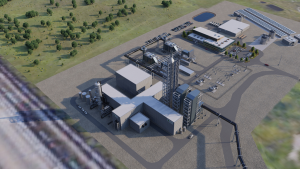At a recent educational conference in Toronto, contractors, manufacturers, consultants and other concrete sector representatives highlighted their sustainability initiatives, products and technologies.
“At Dufferin Concrete, sustainability is embedded in our operations,” said product specialist Derek Lapierre, one of the speakers at the Lower Carbon Concrete Symposium.
Some of the key pillars of Dufferin’s sustainability mission include sourcing raw materials, such as cement and aggregates close to market as well as maintaining a network of accessible and close-to-market ready-mix concrete plants, said Lapierre.
“Moving material in and out of Toronto is difficult.”
A large part of his presentation was devoted to Dufferin’s water recycling initiatives. Of its 31 operating locations, 26 are set up to consume recycled water which is being used in the concrete production as a replacement to the total mix water. In 2024, the company’s consumption of recycled water was 37 million litres.
“We want to preserve our water,” he said.
Focusing on some of Dufferin’s technological advancements, Lapierre cited the in-house development of CarbonJect. This is a technology that mineralizes CO2 in concrete by turning carbon dioxide into a solid.
“It was successfully used in the installation of 6,600 square metres of taxiway pavement at Pearson International Airport.”
In another presentation, the attendees were given a progress update on what might be described as a groundbreaking project.
North America’s first large-scale Carbon Capture Utilization and Storage (CCUS) plant for cement will be in operation by 2029.
“That is 21 years ahead of 2050,” said Heidelberg Materials’ Canadian sustainability and technical marketing manager Shane Mulligan, in reference to Canada’s commitment to achieve net-zero emissions by that year.
To be located at Heidelberg’s Edmonton cement plant, it will achieve a one-million tonnes annual reduction in CO2 emissions, he said.
Flue gas from the cement plant and a planned new combined heat and power facility will be processed at the CCUS plant with an amine solution to isolate the carbon dioxide. It will then be compressed and transported 25 to 30 kilometres by pipe to a CO2 storage hub.
From there it will be interjected underground two kilometres where it will be “permanently and safely” stored in a porous geologic formation known as a saline reservoir processor.
“Why Edmonton? Cost and geology,” said Mulligan, citing the geologic formation which can be found in many parts of Alberta.
In a short interview after the conference, Mulligan said the company has received two competitive front-end engineering and design (FEED) submissions. One is from MHI-LCSC and Kiewit, and the second one from Technip and PCL.
Those submissions have to be analyzed and the company has to complete a due diligence financial review, he said.
Updating the audience on the CCUS project was just one section of his Accelerating to Net Zero Concrete talk which emphasized many of Heidelberg’s other emission-lowering initiatives.
The company is also developing methods to process, reprocess and return demolition concrete to the construction cycle. Those methods include recycling aggregate, crushing and sorting waste into components such as sand and stone, and removing cement stone from sand and gravel.
“Net-zero is possible,” said Mulligan.
But challenges are inherent with low carbon and concrete mitigation initiatives, he warned.
Having been more comfortable with traditional materials that they have used for years, industry professionals may be resistant to adopting new technologies.
Use of low carbon concrete can impact construction and project schedules as it can be less efficient in terms of setting time and strength development. There may also be concerns about the long-term performance and durability of low carbon concrete compared to the well-established traditional concrete.
As existing building codes and standards may “not yet fully accommodate or recognize low carbon concrete, there may be regulatory hurdles. Additional testing and certification may also be required to ensure low carbon concrete meets all necessary standards, adding time and cost,” said Mulligan.
Other precautions and safeguards in the cement-concrete supply chain should be adhered to, another speaker advised.
As part of a lecture on innovative admixture solutions for low-embodied carbon concrete, Master Builders Solutions’ concrete sustainability director Charles Nmai said the use of blended cements such as Portland Limestone Cement is on the rise — at least in the United States.
Portland limestone cement is a blended cement where finely ground limestone is added to traditional Portland cement. This addition reduces the clinker (the primary ingredient in cement) lowering CO2 emissions.
Portland limestone cement has “been a hot topic in the concrete industry,” said Nmai, whose PowerPoint presentation included an image of news articles citing potential problems with its use such as the need for increased water and slower setting times.
Portland limestone cements are not all the same and performance tests should be used to test that performance, he said.
Other technical subjects addressed at the full day conference included the use of fibre reinforcements for carbon footprint reductions and the role of harvested coal ash in creating low carbon cements.
Held at the Toronto Reference Library, the symposium was organized by Concrete Ontario and the Carbon Coalition.








Recent Comments